Legislative Analyst's OfficeAnalysis of the 2002-03 Budget Bill |
The California Department of Corrections (CDC) is responsible for the incarceration, training, education, and care of adult felons and non-felon narcotic addicts. It also supervises and treats parolees released to the community.
The department now operates 33 institutions, including a central medical facility, a treatment center for narcotic addicts under civil commitment, and a substance abuse treatment facility for incarcerated felons. The CDC system also includes 12 reception centers to process newly committed prisoners; 16 community correctional facilities; 38 fire and conservation camps; the Richard A. McGee Correctional Training Center; 34 community reentry, restitution, and drug treatment programs; 136 parole offices; and 4 outpatient psychiatric services clinics.
The budget proposes total expenditures of $4.8 billion for CDC in 2002-03. This is $28 million, or about 1 percent, below the revised estimate for current-year expenditures. The primary causes of this decrease are a projected decline in the inmate population and a proposed shift of funding for certain programs from the General Fund to special funds.
General Fund Expenditures. Proposed General Fund expenditures for the budget year total almost $4.7 billion, a decrease of $2.2 million, or less than 1 percent, below the revised current-year estimate.
Federal Fund Expenditures. The Governor's budget assumes that the state will receive about $208 million from the federal government during 2002-03 as partial reimbursement of CDC's costs (estimated to be $567 million in the budget year) of incarcerating inmates in prison and supervising felons on parole who are illegally in the United States and have committed crimes in California. This is $50 million higher than the state is estimated to receive in the current year. The federal funds are not included in CDC's budget display, but instead are scheduled as "offsets" to its total state General Fund expenditures.
Figures 1 through 5 illustrate the characteristics of the state's prison population, which was 161,483 as of June 30, 2001. About 93 percent of the population is male. The charts show:
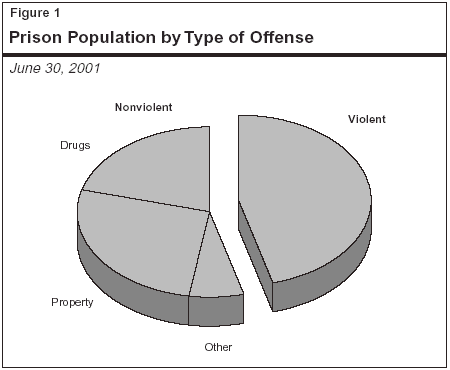
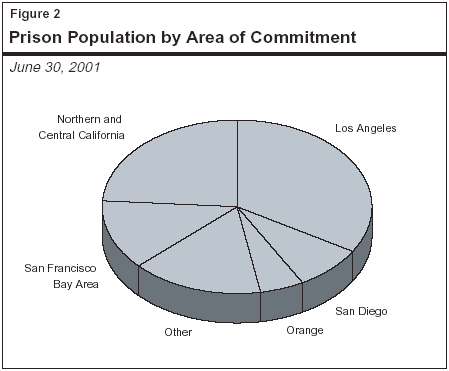
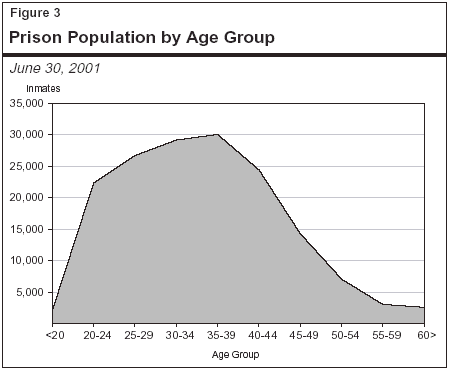

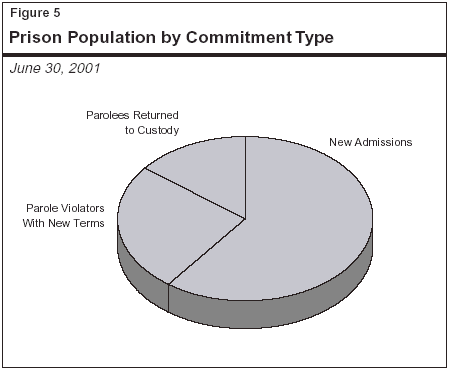
In a major shift from the prison growth experienced in the past two decades, the California Department of Corrections is projecting that the prison population will decline in the current year and stabilize for a few years before resuming its gradual climb upward.
Inmate Population Decline. As of June 30, 2001, the CDC housed 161,500 inmates in prisons, fire and conservation camps, and community correctional facilities. Based on the fall 2001 population forecast prepared by CDC, the inmate count will drop to 156,400 by June 30, 2002, a decline of approximately 5,000 inmates, or 4 percent, from a year ago. The inmate population is expected to stabilize at about 156,000 through 2004 then gradually increase to 165,000 inmates by 2007.
Parole Population Decline. As of June 30, 2001, the CDC supervised 119,600 persons on parole. The fall 2001 projections assume that the parole population will increase slightly to 120,500 as of June 30, 2002, and then will decline to 116,800 by June 30, 2003. These figures assume a parole population increase of 1 percent in the current year and a decrease of 3 percent during the budget year. The fall 2001 projections also assume that the parole population will continue to drop during the following four years, reaching a low of 105,000 parolees by June 30, 2007.
Change From Prior Projections. The fall 2001 projection of the inmate population has decreased from the prior CDC forecast (spring 2001), which was the basis for the 2001-02 Budget Act. The new fall 2001 forecast for June 30, 2002 is about 1,250 inmates lower than the spring forecast. As can been seen in Figure 6, the differences between the spring 2001 and fall 2001 inmate projections generally widen with time over the projection period. By 2005-06, the difference is about 6,800 inmates.
As regards the parole population, the fall 2001 projection reflects a significant decrease relative to the prior spring 2001 CDC forecast. The new fall 2001 forecast for June 30, 2002 is 5,600 parolees fewer than the spring forecast. As can be seen in Figure 7, the differences between the spring 2001 and fall 2001 parole projections also widen with time over the projection period until the differential exceeds 8,800 parolees at the end of 2005-06.
|
Figure 6 Total Inmate Population |
|||
|
June 30 Population |
Projection as of: |
Difference |
|
|
Spring 2001 |
Fall 2001 |
||
|
2002 |
157,660 |
156,409 |
-1,251 |
|
2004 |
161,211 |
156,337 |
-4,874 |
|
2006 |
168,010 |
161,159 |
-6,851 |
|
|
|||
Why the Forecasts Changed Between Spring and Fall 2000. According to CDC, several factors appear to have caused the inmate population to drop during the latter part of 2001. The CDC data indicate that fewer parole violators than projected are being returned to prison by administrative actions of the Board of Prison Terms, and that they are serving slightly less time in prison than had been expected. Moreover, fewer parolees than anticipated are being returned to state prison by the courts.
|
Figure 7 Total Parole Population |
|||
|
June 30 Population |
Projection as of: |
Difference |
|
|
Spring 2001 |
Fall 2001 |
||
|
2002 |
126,149 |
120,523 |
-5,626 |
|
2004 |
120,170 |
112,301 |
-7,869 |
|
2006 |
115,763 |
106,882 |
-8,881 |
|
|
|||
Potential Risks to Accuracy of Projections. As we have indicated in past years, the accuracy of the department's latest projections remain dependent upon a number of significant factors. These include:
Significant changes in any of these areas could easily result in a prison growth rate higher or lower than the one contained in CDC's projections.
We withhold recommendation on the 2002-03 budget request for caseload funding. Although more recent data indicate that population is trending slightly higher than the department's projection, we see no reason to adjust the budget request at this time. We will continue to monitor the caseload and recommend further changes, if necessary, following our review of the May Revision.
Actual Inmate Count Is Slightly Higher Than Fall Projections. During the first half of 2001-02, the prison population had been projected to decrease by about 5,300 inmates relative to the prior year. Instead, it decreased by about 4,300. The CDC data indicate that there have been more new admissions than anticipated. A number of factors have probably contributed to this result, including the downturn in the economy and the resulting increase in crime rates. An additional factor is a lower than anticipated decline in admissions attributable to Proposition 36. This measure changed state law so that certain adult offenders who use or possess illegal drugs would receive drug treatment and supervision in the community rather than be sent to state prison.
Current-Year Effect. Based on the inmate population as of the end of December 2001, we estimate that the average daily population of the prison system in 2001-02 will be about 518 inmates above the caseload actually funded in the Governor's budget plan. We further estimate that the average daily parole population will be about 435 inmates lower than the caseload funded in the Governor's budget plan. The net effect of these two changes would be an increase in current-year costs of about $6 million.
Budget-Year Effect. The CDC forecast assumes that new admissions will remain relatively flat between the current and budget years rather than drop as they have for the past four years. The recent data appear to support this assumption. However, it is unclear whether this trend will in fact continue in the budget year. Part of the uncertainty lies in the lack of information about what is actually causing the decline in new admissions to slow down. For example, we cannot determine whether this is largely the result of larger factors such as the increasing crime rate, or more reflective of a slower than anticipated implementation of Proposition 36.
The CDC will issue updated population projections in spring 2002 that form the basis of the department's May Revision proposal. At that time, we will review whether further adjustments to CDC's funding for inmate and parole caseloads are warranted.
Analyst's Recommendation. We withhold recommendation on the 2002-03 caseload funding request. We will continue to monitor CDC population, and make recommendations as appropriate at the time of the May Revision.
We withhold recommendation on the California Department of Corrections' (CDC's) inmate housing plan because the inmate population is trending slightly higher than projected, thus making the housing plan obsolete. We anticipate the CDC will revise the housing plan at the time of the May Revision.
Despite the fact that the inmate population is declining in the current year, the prisons will generally continue to be overcrowded. Under the housing plan, some of the beds that were projected to no longer be needed in the budget year would be filled with low-level offenders from the community correctional facilities (CCFs) and the community correctional re-entry centers (CCRCs). This is the result of the Governor's budget proposal to deactivate some of the CCFs and CCRCs. While this proposal would result in higher crowding levels in the budget year, the prisons will be generally less crowded than they were in the prior fiscal year.
Analyst's Recommendation. Because the inmate population is running slightly above the fall 2001 projections upon which the CDC housing plan was based, it is likely that the plan will change somewhat by the May Revision. Thus, we withhold recommendation on the plan at this time pending receipt of CDC's revised prison inmate population projections and the updated housing plan provided in the May Revision.
The Governor's budget assumes that the state will receive an additional $50 million from the federal government for the costs of incarcerating undocumented felons. There is considerable uncertainty regarding this assumption given that the President's 2002-03 budget proposes to eliminate the grant program.
The Governor's budget assumes that the state will receive about $208 million from the federal government during 2002-03 as partial reimbursement of CDC's costs of incarcerating inmates in prison and supervising felons on parole who are illegally in the United States and have committed crimes in California. We believe there is considerable uncertainty regarding the budget's assumption of increased federal funds. In order for California to receive the assumed level of federal funds, the national appropriation in federal fiscal year 2002-03 would have to increase by approximately $265 million. This would be the single largest increase in funding for this program since its inception. At this point, there is no information that would lead us to expect this level of funding. We would note that the President's 2002-03 budget proposes to eliminate funding for this grant.
The budget proposes to deactivate five community correctional facilities and 425 community correctional reentry center beds for a net savings of $8.5 million. Our review finds that these savings are overstated by $4 million because the estimate is based on a current year rather than a budget year estimate of costs.
The CDC currently contracts with public and private entities for the operation of 15 CCFs throughout the state. The CCFs are essentially small prisons that house low-risk inmates. The Governor's budget proposes to deactivate five CCFs in the budget year and transfer approximately 1,435 inmates to other prison facilities for a net General Fund savings of $5.1 million in 2002-03.
The budget-year savings estimate was calculated using the estimated inmate-overcrowding rate for the current year ($13,476), rather than the more appropriate rate for the budget year ($14,797). Using the budget-year rate, we estimate that the net savings would be about $2.8 million, not $5.1 million as included in the Governor's budget.
A similar technical adjustment is required to calculate the net savings of the proposed deactivation of 425 community correctional center re-entry CCRC beds. The budget assumes that this action will result in net savings of $3.4 million in the budget year. Using the budget-year overcrowding rate, we estimate this would instead result in net savings of about $1.7 million.
We recommend that the Department of Corrections report prior to budget hearings on its efforts to address its structural budget problems, and how these problems will impact the department's revised budget for 2001-02 and the proposed budget for 2002-03. We further recommend that the department be required to provide, at the time of the May Revision, a detailed analysis of the fiscal impact of the new Memorandum of Understanding between the state and Bargaining Unit 6.
Background. The CDC has had General Fund deficiencies for several consecutive years. These deficiencies have ranged from several tens of millions of dollars to hundreds of millions of dollars. This is due largely to ongoing structural problems with the department's budget. According to the department, the budget deficits are the result of unfunded merit salary adjustments (MSAs), court orders that drive program expansions and, most notably, the high vacancy rate for correctional officers, which necessitates the use of overtime to maintain prison security. It may also be due, to a lesser extent, to ineffective budgeting practices. We would note that--unlike most departments, CDC has received funding to address the need for MSAs; however, this has been irregular.
2000-01 Budget Deficiency. In 2000-01, the department submitted a deficiency request to the Legislature totaling $52 million. The deficiency level would have been approximately $136 million, but one-time savings in other areas of the budget offset part of this amount. According to the department, this deficiency was driven largely by the factors discussed below.
Departmental Efforts at Controlling Spending. In response to past legislative efforts and audit reports, the department has implemented some strategies that could ultimately allow it to better control spending. These strategies include the development and implementation of information management processes that enable the department to better track institution expenditures on a monthly basis, as well as track employee use of overtime and sick leave. In addition, the department has implemented an aggressive correctional officer recruitment plan. The Legislature also recently provided funding for CDC to expand the cadet training academy.
Additional Spending Control Efforts Needed. While we agree that these are significant efforts, it is likely that the department will have to take additional steps in order to live within its budgeted appropriation. A recent Bureau of State Audits (BSA) report, for example, found that CDC continues to have problems implementing basic strategies that would allow it to contain pharmacy and contract medical costs. According to the BSA report, the CDC's current system of procuring, dispensing, and monitoring prescription drugs use is antiquated. Another recent BSA report found that the department's fiscal practices and internal controls are inadequate to ensure fiscal responsibility. This report also found that the standard cost factors used by the department to determine the budget for inmate and staff operating expenditures are outdated and do not reflect the department's true needs. (We discussed the CDC's difficulties in managing health care and personnel expenditures in more detail on page D-49 and D-51 of the Analysis of the 2000-01 Budget Bill.)
We do not believe that the strategies implemented by the department to date, will have a significant impact on the department's budget in the near term. This is because some of the department's plans, such as the recently approved financial management system redesign, have not yet been fully implemented. In addition, the department still continues to have a high number of correctional officer vacancies. As of November 30, 2001, the department had approximately 1,400 correctional officer vacancies, a 7 percent vacancy rate. This compares to 1,374 correctional officer vacancies (or 7 percent) a year earlier. We have no reason to believe that the department will be able to fill most of these positions within the year. Therefore, related overtime and sick leave costs will likely continue. As regards medical care costs, the department continues to lack the information system necessary to control medical and pharmacy costs. According to the department, it does not expect such an information system to be operational until 2006.
The recent enactment of the new memorandum of understanding (MOU) between the state and Bargaining Unit 6 (the California Correctional Peace Officers Association) may contribute to the department's budget problems if it is not fully funded. At the time this analysis was prepared, the CDC was still working with the Department of Finance to develop a more comprehensive estimate of the fiscal impact of the new MOU.
In view of the above, we expect that the CDC will continue to face major budget deficiencies. Based upon our analysis of past-year deficiencies and our discussions with CDC, we believe the deficiency could potentially be in the range of $100 million in both the current and budget years.
Analyst's Recommendation. We recommend that CDC report prior to budget hearings on its efforts to address its ongoing budget problems, identifying factors that are likely to continue to drive costs and discuss the potential impact of these factors on its proposed budget for 2001-02 and 2002-03. We further recommend that the department be required to provide, at the time of the May Revision, a detailed analysis of the fiscal impact of the new MOU between the state and Bargaining Unit 6.
The decline in the female inmate population provides the state the opportunity to close one of the women's prisons. We recommend that the California Department of Corrections report at budget hearings on the feasibility, costs, and benefits of closing the Northern California Women's Facility, as well as on other potential current and future uses for the prison facility in the event it were closed.
Background. The state currently operates five women's prisons. These prisons are located in central and southern California, including two in Madera County, one in San Joaquin County, one in Riverside County, and one in Orange County. The oldest women's institution, the California Institution for Women, opened in 1952. The newest, the Valley State Prison for Women, opened in 1995. In total, these five prisons are designed to house approximately 5,900 female inmates, assuming one inmate per cell. However, for the past decade, the actual population has been such that many cells contain two inmates rather than one. Such cells are considered "double-bunked."
Decline in Female Population. The female inmate population grew steadily during the 1990s, going from 6,400 in 1990 to a high of about 11,500 in 1999. However, this trend appears to have reversed, as the population has declined for two consecutive years. Between June 30, 1999 and June 30, 2001, the female population dropped by 771 inmates, or about 7 percent. Based on CDC's most recent projections (fall 2001), the female inmate population is expected to drop by another 950 inmates, or 9 percent, by the end of the budget year. We would note that recent data show that the actual number of female prisoners is trending slightly lower than CDC's estimate for the current year, so the decline may be greater than CDC suggests.
Similar to the overall inmate population trend discussed earlier, CDC projects that the female population will level off in the budget year, stabilize at about 9,800 inmates through 2005, and then gradually increase to about 10,600 by the end of 2007. The CDC projects that between 2005 and 2007 the number of female inmates will grow by about 800.
Figure 8 below shows the actual and projected change in the female inmate population for the period June 1999 through June 2007.
Benefits and Costs of Closing a Prison. Given the major shift in the female population, the state now has the opportunity to consider closing one or more of its women's institutions. The major benefit of closing one or more prisons is the savings to the state and its taxpayers. This benefit, however, should be weighed against the costs associated with double-bunking a greater number of female inmates (also known as "overcrowding"). Generally, these costs involve the greater likelihood of prison incidents due to overcrowding. These issues are discussed in detail below.
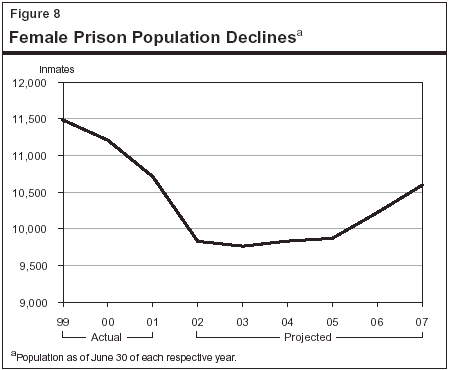
Prison Closure Savings. Although the female prisons are currently operating above design capacity, as indicated above, there continue to be "excess beds" systemwide that could be used if needed. This is because many prison cells currently house only one inmate. The CDC estimates that there are currently over 2,600 excess beds in the women's institutions.
The Double-Bunking (or Overcrowding) Trade-Off. Closing a prison would require that inmates residing in that institution be transferred to other facilities, thereby increasing the inmate population at the receiving institution(s). These inmates generally would be absorbed in the other facilities by placing an additional inmate in a cell that currently has one inmate, or double bunking. Since the design capacity of prisons assumes one inmate per cell, this has also been referred to as overcrowding. In this sense, there has always been some level of overcrowding. Currently, it is estimated that approximately 57 percent of the prison cells in women's institutions house two inmates, which equates to an overcrowding rate of 157 percent. This figure has been as high as 90 percent (or 190 percent overcrowding) in the past.
It has been argued that increasing the number of inmates in a given prison reduces the level of safety for both the inmates and employees. This is because with the higher number of inmates comes a potentially increased number of dangerous incidents. We would note, however, that the potential for an increased number of dangerous incidents is not equally distributed across all prisoners. For example, data show that male inmates tend to be more violent than female inmates. In addition, according to CDC, female inmates generally tend to do better in a shared cell situation than male inmates. We would also note that female prisons have a higher percentage of low-level offenders than male prisons, thus making them generally safer for both the employees and the inmates.
Which Women's Prison Could the State Close? If the Legislature decided to close a women's prison, the choice of which prison to close would depend on several factors. These factors include the per capita costs of operating the prison, the proximity of the prison to other prisons, and the ability of other prisons to absorb the inmates and employees from the closed prison. Applying these criteria, Northern California Women's Facility (NCWF) would be the most likely candidate for closure. First, it is one of the most costly prisons to operate. This is because the NCWF population is small (630 inmates), yet like other prisons it has relatively high operating costs. Second, NCWF is one of the easiest prisons to close. Because this is a relatively small facility, other institutions can more easily absorb the inmate population and with less overcrowding. In addition, there would be fewer employees who need to relocate because of the proposed closure.
The proximity of NCWF to other CDC facilities would make it easier and less costly to relocate NCWF employees. Based upon information provided by the State Controller's Office, there were 238 filled positions at NCWF as of October 31, 2001. We would note that there are currently enough vacant positions at nearby CDC institutions--within 35 miles of NCWF--to absorb approximately 200 of these employees.
The CDC estimates that closure of NCWF would result in net savings of $8.7 million in the budget year and $10.3 million annually thereafter. This is a net figure because its already accounts for costs associated with transporting the inmates to the other facilities and relocating employees. This estimate assumes that CDC begins to implement the closure plan by July 2002.
Where Would the Inmates be Transferred? Based on information provided by CDC, the two largest women's prisons, the Central California Women's Facility (CCWF) and the Valley State Prison for Women (VSPW) both located in Chowchilla (Madera County), would be the best place to transfer inmates from NCWF. The size of these prisons makes it easier to absorb the inmates from NCWF. These prisons are expected to have a sufficient number of excess beds. Based upon CDC's recent population estimates, after June 2003, there will be about 2,400 surplus general population and reception center beds between CCWF and VSPW, so there is more than enough capacity to absorb the NCWF population.
As we indicated earlier, CDC projects the female population will begin to increase starting in 2005. Between 2005 and 2007 (the end of the projection period), the department projects the population will rise by about 800 inmates. We would note that, even after the prison closure, there would continue to be approximately 1,800 excess beds between CCWF and VSPWfar more than enough to handle the projected systemwide increase in female inmates over the next five years.
How Would NCWF Closure Impact Overcrowding at CCWF and VSPW? Under the Governor's proposed budget, CCWF and VSPW would have an overcrowding rate of 158 percent and 159 percent, respectively. It is estimated that closing NCWF and transferring the inmates to these facilities would raise the rates to 166 percent and 167 percent respectively, which while higher than the level proposed in the Governor's budget, continues to be lower than the 175 percent to 177 percent overcrowding rates experienced in 1998-99.
Potential Future Use of NCWF. We would note that closure of the prison as a women's facility provides the opportunity to use it for other correctional purposes. For example, should the male population increase to a level that requires the activation of new prison beds, the NCWF facility could be retrofitted for males instead of activating a new prison. This would cost significantly less than construction and activation of a new prison facility.
Conclusion. The decline in the female inmate population provides the state the opportunity to close one of its smaller women's prisons. Should the state decide to close a facility, we recommend closing the NCWF, and transferring its inmates to the CCWF and the VSPW. We also note that closure of the NCWF would provide an opportunity for the state to find alternative uses for the prison facility. We recommend that the CDC report at budget hearings on the feasibility, costs and benefits of closing NCWF, as well as on other potential current and future uses for the prison facility in the event it were closed.
We recommend that the Legislature reduce the Department of Corrections (CDC) General Fund budget by $7.1 million because it is likely to use fewer beds than projected in state mental hospitals operated by the Department of Mental Health. We further recommend denial of a $427,000 General Fund augmentation to CDC for additional security at Patton State Hospital because a slowdown in hospital population growth means that these additional beds are not needed in 2002-03. Finally, we recommend that the CDC budget be adjusted if activation of a new mental health facility at Salinas Valley State Prison is delayed. (Reduce Item 5240-001-0001 by $7.5 million.)
In our analysis of the 2002-03 budget request for the Department of Mental Health (DMH), we examine several issues that would affect the level of funding budgeted for CDC. These issues relate to (1) the number of hospital beds provided for CDC inmates receiving treatment in state mental hospitals; (2) a proposal to activate additional state hospital beds at Patton State Hospital, for which CDC provides perimeter security; and (3) a potential delay in the activation of a new DMH-staffed mental health facility at Salinas Valley State Prison.
We discuss our findings and recommendations in regard to these issues in our analysis of the DMH budget, which can be found in the "Health and Social Services" chapter of this Analysis.